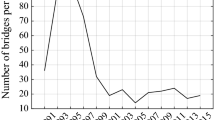Abstract
In recent years, the replacement repair welding has been suggested as a repair method for damaged steel bridges. The distinguished feature of the method is that it can be carried out without incurring traffic dislocation. However, the method has not ever been attempted because of its lack of certainty for safety, i.e., repair method by welding inevitably involves cutting and welding processes, and the safety during these processes has not been established yet. This paper describes the strengthening of a damaged steel girder bridge through the replacement repair welding. Field load test was conducted both during and after the replacement repair welding, and the response of the bridge to test vehicle loading was recorded. Results of the field test are reported, and the validity of the replacement repair welding during in-service loading is identified.
Similar content being viewed by others
References
American Association of State Highway and Transportation Officials (AASHTO) (1996). Standards specifications for highway bridges, 16th ed. Washington, D.C.
Boothby, T. E. and Craig, R. J. (1997). “Experimental load rating study of a historic truss bridge.” Journal of Bridge Engineering, Vol. 2, No. 1, pp. 18–26.
Chang, K. H. (2006). Development of repair and strengthening method by replacement repair welding of steel bridge under loading, Final Report to the Ministry of Construction and Transportation (MOCT). Korea.
Chang, K. H., Choi, U. H., Lee, C. H., Lee, J. H., and Yang, Y. J. (2006). “An experimental investigation of the replacement repair welded joints of structural steel after a period of prolonged service.” Proceedings of Korean Welding Society (KWS), Vol. 47, pp. 277–279.
Ji, H. S., Son, B. J., and Chang, S. Y. (2007). “Field testing and capacityratings of advanced composite materials short-span bridges superstructures.” Composite Structures, Vol. 78, No. 2, pp. 299–307.
Korean Society of Steel Construction (KSSC) (2000). “Steel highway bridges in Korea.” Magazine of Korean Society of Steel Construction, Vol. 12, No. 3, pp. 146–147.
Lee, S. H. (2003). A study on the mechanism of the stress generated by replacement repair welding and repair method of steel bridge, PhD Thesis, Chung-Ang University.
Lee, C. H. and Chang, K. H. (2007). “Numerical analysis of residual stresses in welds of similar or dissimilar steel weldments under superimposed tensile loads.” Computational Materials Science, Vol. 40, No. 4, pp. 548–556.
Lee, C. H. and Chang, K. H. (2008). “Numerical investigation of the residual stresses in strength-mismatched dissimilar steel butt welds.” Journal of Strain Analysis for Engineering Design, Vol. 43, No. 1, pp. 55–66.
Lee, S. H., Chang, K. H., Lee, C. H., and Kim, S. H. (2003). “Behavior of stress and deformation generated by repair welding of steel bridge.” Proceedings of the 9th East Asia Structural Engineering Conference (EASEC), pp. 78–84.
Leggatt, R. H. (2008). “Residual stresses in welded structures.” International Journal of Pressure Vessels and Piping, Vol. 85, No. 3, pp. 144–151.
MIDAS IT (1989). MIDAS CIVIL, version 7.0.2.
MIDAS IT Co., Ltd. Ministry of Construction and Transportation (MOCT) (2000). Standards specifications for highway bridges, 2nd ed. Korea.
Roeder, C. W., Barth, K. E., and Bergman, A. (2004). “Effect of liveload deflections on steel bridge performance.” Journal of Bridge Engineering, Vol. 9, No. 3, pp. 259–267.
Richard, M. and Andreas, A. (2006). “Field testing and simulation of dynamic properties of a tied arch railway bridge.” Engineering Structures, Vol. 28, No. 1, pp. 143–152.
Stallings, J. M., Tedesco, J. W., El-Mihilmy, M., and McCauley, M. (2000). “Field performance of FRP bridge repair.” Journal of Bridge Engineering, Vol. 5, No. 2, pp. 107–113.
Stewart, M. G. and Val, D. V. (1999). “Role of load history in reliabilitybased decision analysis of aging bridges.” Journal of Structural Engineering, Vol. 125, No. 7, pp. 776–783.
Spyrakos, C. C., Raftoyiannis, I. G., and Ermopoulos, J. C. (2004). “Condition assessment and retrofit of a historic steel-truss railway bridge.” Journal of Constructional Steel Research, Vol. 60, No. 8, pp. 1213–1225.
Taljat, B., Radhakrishnan, B., and Zacharia, T. (1998). “Numerical analysis of GTA welding process with emphasis on post-solidification phase transformation effects on the residual stresses.” Materials Science and Engineering A, Vol. 246, Nos. 1–2, pp. 45–54.
Withers, P. J. (2007). “Residual stress and its role in failure.” Reports on Progress in Physics, Vol. 70, No. 12, pp. 2211–2264.
Author information
Authors and Affiliations
Corresponding author
Rights and permissions
About this article
Cite this article
Park, HC., Lee, CH. & Chang, KH. Strengthening a damaged steel girder bridge by the replacement repair welding. KSCE J Civ Eng 16, 1243–1249 (2012). https://doi.org/10.1007/s12205-012-1570-0
Received:
Accepted:
Published:
Issue Date:
DOI: https://doi.org/10.1007/s12205-012-1570-0




